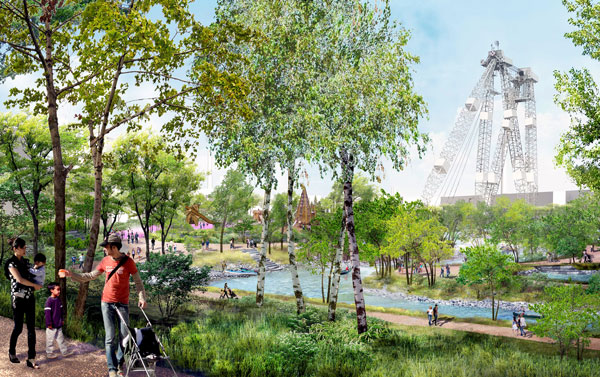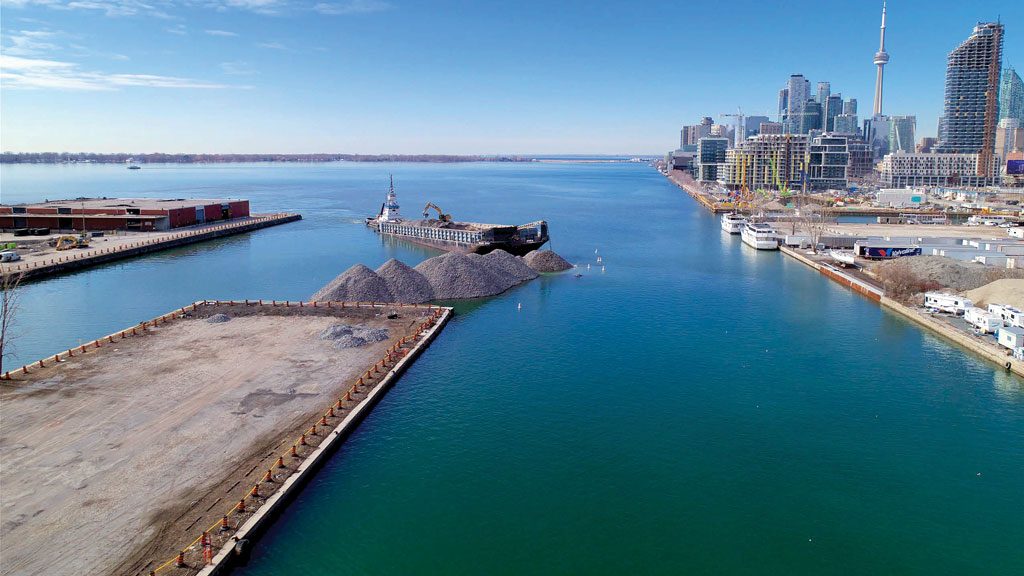The rehabilitation of Toronto’s Port Lands, long seen as a key to righting past environmental wrongs as well as an essential catalyst to new community-building in the area, is now well underway after a decade of planning.
Waterfront Toronto is engaged in numerous projects in the area including such elemental work as the Cherry Street Lakefilling project, the recent launch of the Port Lands Flood Protection Project and continued high-level sustainability planning.
A century ago Toronto filled in wetlands at the mouth of the Don River to enable industrial development and redirected the river. Returning the Port Lands to their original state and rebuilding the land’s natural flood protection capacity became a significant focus of Waterfront Toronto upon its founding in 2001. The revitalization took a step closer to being realized when Prime Minister Justin Trudeau joined other politicians in announcing $1.25 billion in shared funding to support the Port Lands Flood Protection Project in June 2017.
Waterfront Toronto chief project officer David Kusturin recently laid out the progress that has been made on the Cherry Street project this year while Waterfront Toronto’s innovation and sustainability manager Aaron Barter discussed a vision for the sustainable community to be built on the newly created Villiers Island at the Port Lands part way through the next decade.
Work started on Cherry Street lakefilling in winter 2017 and is targeted for completion by March 2020. Components of the job have included depositing clean fill into the lake, creating new land around Essroc Quay, construction of a new dock wall and marine landscaping including shaping the core stone that will form water habitats. Demolition of derelict buildings along Commissioners Street was part of the July work plan.

The land being created will form the foundation of the future Promontory Park on Villiers Island. Meanwhile, work on the flood protection project got underway in July.
“Everything right now is on schedule and on budget, with no surprises,” Kusturin reported. “We are still doing a fair bit of site characterization for the broader Port Lands project so we are still out there doing environmental and geotechnical testing as we continue with the design.”
Work on the dock walls is progressing smoothly.
“The dock walls are all in and have been cut to depth, the tiebacks for the dock wall are in the final throes of being installed and we start backfilling to the dock walls very shortly,” Kusturin explained.
EllisDon is working as construction manager on the Cherry Street build, CH2M is the lead engineer and Michael Van Valkenburgh Associates Inc. is the landscape architect.
The Cherry Street project is about 60 per cent complete and it is on target for completion in the first quarter of next year, Kusturin said.
Eventually, explained his colleague Barter, once full flood protection measures have been implemented for the Port Lands circa 2023, development will start on the Villiers Island Precinct. It is planned that the new 88-acre island will have 54 developable acres, to include mixed uses, and 34 acres of parks and public space. Urban Strategies Inc. has been the precinct planning lead.
The sustainability goal, said Barter, is ambitious: to be climate positive, described in the precinct plan approved by the City of Toronto last December as “a roadmap that leads new developments to achieve net-negative operational greenhouse gas emissions associated with energy, waste and transportation.”
The principles were developed through the Villiers Island Sustainability Audit, Barter explained.
“The Villiers Island Sustainability Audit is a visionary document for the future community that will be built at Villiers Island — what could that future community look like and what will the sustainability goals of that future community be,” Barter said.
Six neighbourhood design recommendations were identified to achieve the climate positive target: design to Passive House standards; optimize the urban form for energy harvesting and conservation; maximize photovoltaic capacity; reduce car travel to 25 per cent of trips or less and/or restrict the island to electric vehicles; meet remaining energy demand with district energy including cogeneration; and design with the climate positive goal in mind.
Among those recommendations, building orientation looks to have huge potential, Barter said.
“The strategy was to orient building in such a way that there would be optimal solar gain for heating purposes,” he explained, noting there was extensive 3-D modelling done. “We did a lot of different iterations of this and we worked closely with city planning to come to final recommendations that…allow for solar access for the most amount of buildings possible.”
The result was a possible 28-per-cent reduction in heating energy use over just Passive House standards.
“It is a huge challenge,” said Barter of the climate positive targets. “There are cities around the world who are on the climate positive network who are working on this challenge and we are in touch with those cities on a regular basis to determine what they have done and what has been successful and not successful.”











Clean soil is in short supply in Toronto. Have far and where does this soil come from?
I thought we had stopped putting housing in areas prone to flooding. What sort of flood protection plans can counteract the lake when it’s waters are high? And at what expense?